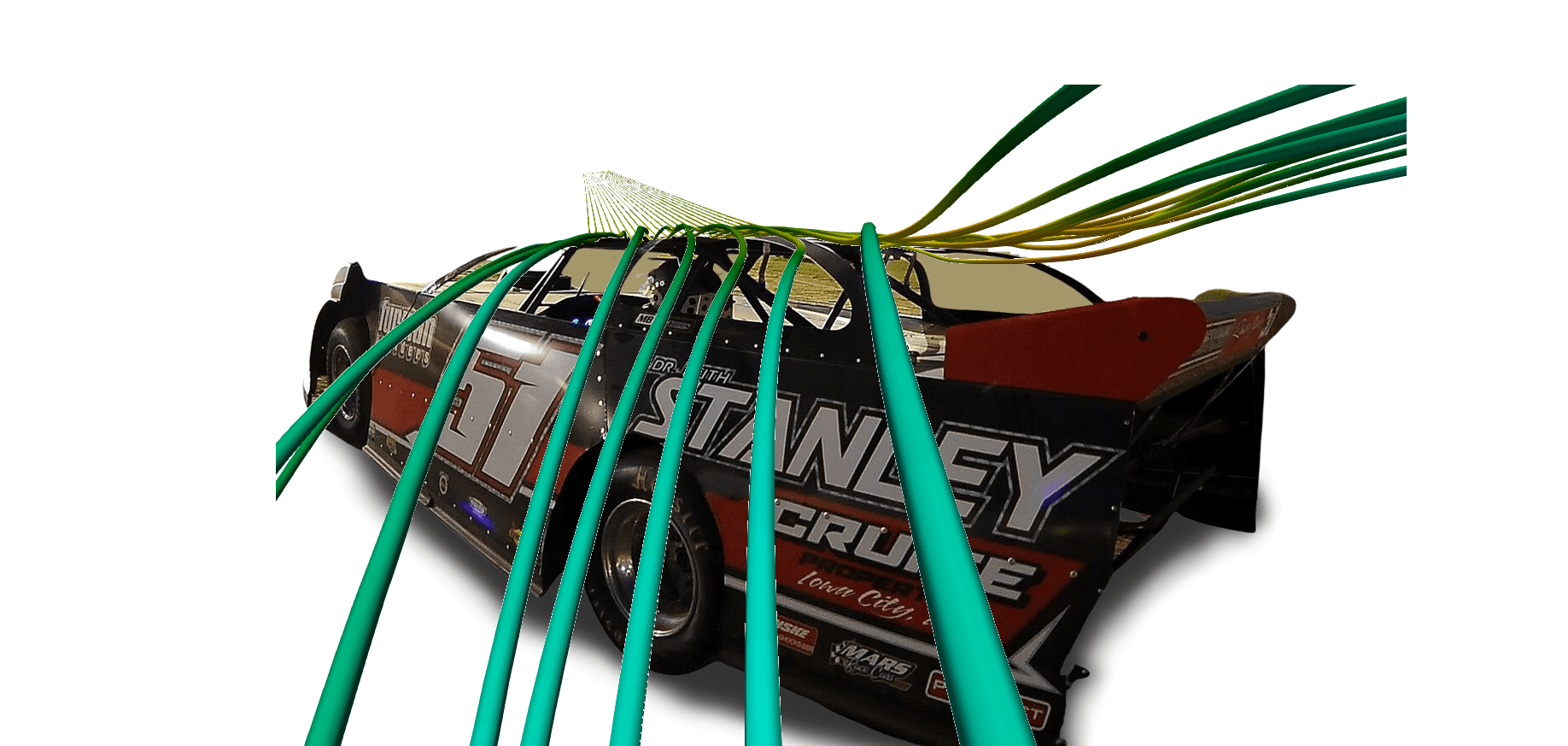Last year we wrote an article about aerodynamic analysis using CFD of a Dirt Late Model that garnered a lot of attention. On that model one of the most prominent aerodynamic devices is the rear spoiler. One question that often comes up is, what is the difference between a spoiler and a wing? Some people think the terms are interchangeable. In this post we will help illustrate why and how they are different with the aide of some CFD analysis
What is CFD?
Computational fluid dynamics (CFD) is a branch of fluid mechanics that uses computer numerical analysis and data structures to analyze and solve problems that involve fluid flows, typically solved on large supercomputers. Fluid mechanics plays a significant role in the engineering process when developing new designs. Analyzing the aerodynamic and thermal qualities of a product using experimentation is a well established approach however experimentation can be costly, limiting, time consuming, and difficult to execute especially on a large scale. Progression of computing power has allowed the field of CFD to prosper acting as a compliment to physical testing and in some cases replacing it. CFD is the science of predicting fluid flow, heat transfer, mass transfer, chemical reactions, and other flow properties by solving governing fluid flow equations using numerical methods. Across industry CFD is routinely used to drive product development, troubleshoot issues, study and optimize new designs and concepts and map performance. CFD methods are heavily used across many disciplines with motorsports being a leading proponent.
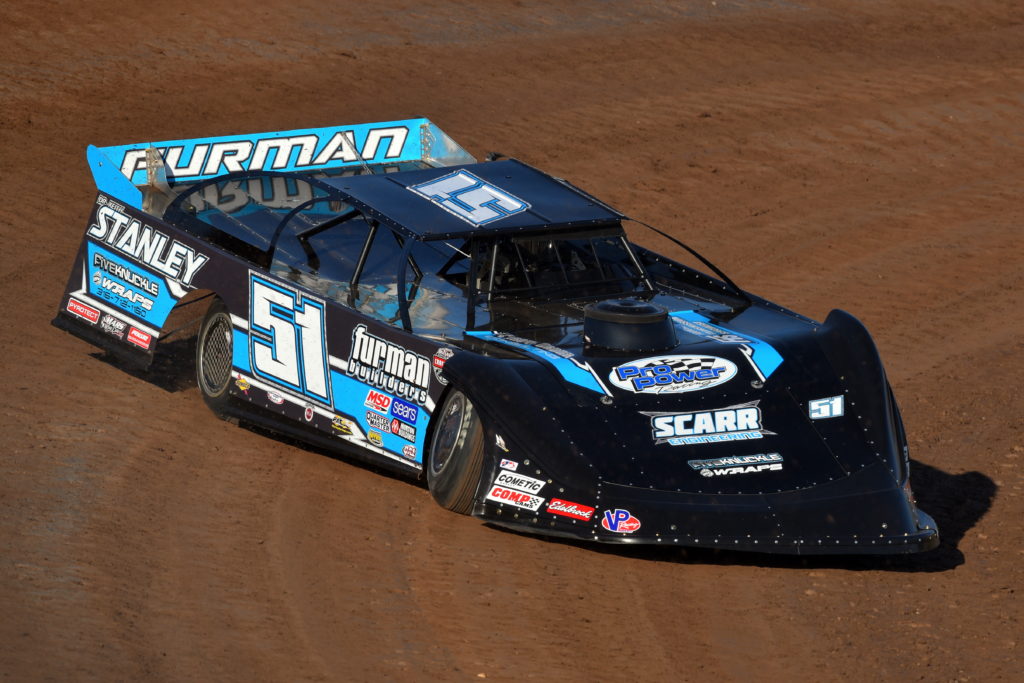
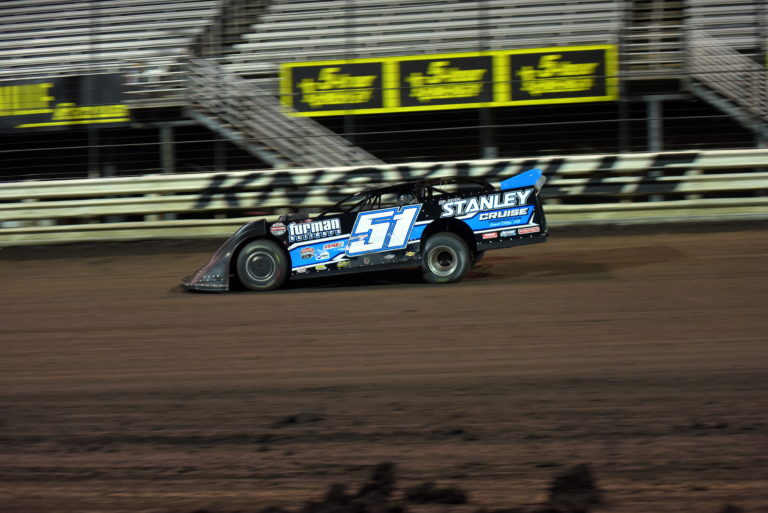
Dirt Late Model [Photos by Boyd] [1]
The Dirt Late Model CAD [2] was drawn by Matthew Furman, who is also both owner and driver of the car. The digital twin was created using Siemens NX. The vehicle dynamics was analyzed using the dynamics program Simcenter 3D Motion and used NX to organize the data. The CAD was then imported directly it to TotalSim’s TS Auto App and the aerodynamics performance was assessed in the cloud.
First, the basics (some math, but not too much…)
In fluid mechanics, we often cite Bernoulli’s Principle, which states that total pressure for well behaved incompressible flows remains constant. In other words

Defining dynamic pressure (often denoted as q) as

Defining and buoyant pressure as

Note that for most cases, the height variation for the fluid of interest is small enough that the change in Pbuoyancy is negligible. As such, aerodynamicists frequently remove Pbuoyancy from equation 1
We can rewrite equation 1 as

Solve for Pstatic2

For incompressible fluid, we generally assume that density remains constant. Therefore if Velocity2 is greater than Velocity1, then q2 > q1 because velocity magnitude is always positive and velocity^2 (velocity squared) is definitely positive for real values. Conversely, if Velocity2 is less than Velocity1, then q2 < q1. This leads us to the conclusion

One final note about this conclusion, change in pressure is not a result of change in velocity nor vice-versa; the 2 quantities are coupled. Equation 6 allows us a quick way to estimate the flow quantity of either Pstatic2 if we already know Velocity2 or conversely allows us to estimate Velocity2 if we know Pstatic2.
Vehicle Lift
Most automotive vehicles by nature have more curvature over the upper surface than the lower due to functional requirements (e.g. fitting a person in the car). This curvature on the upper surface acts similar to a cambered airfoil which, at 0 degrees angle of attack, produces positive lift due to the low pressure on the upper surface.
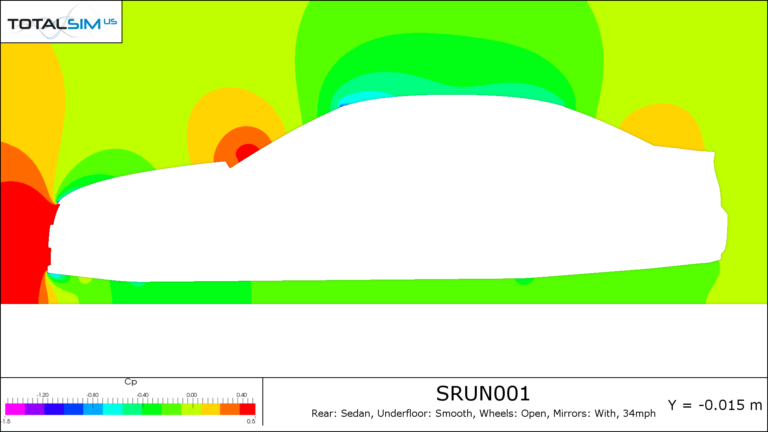
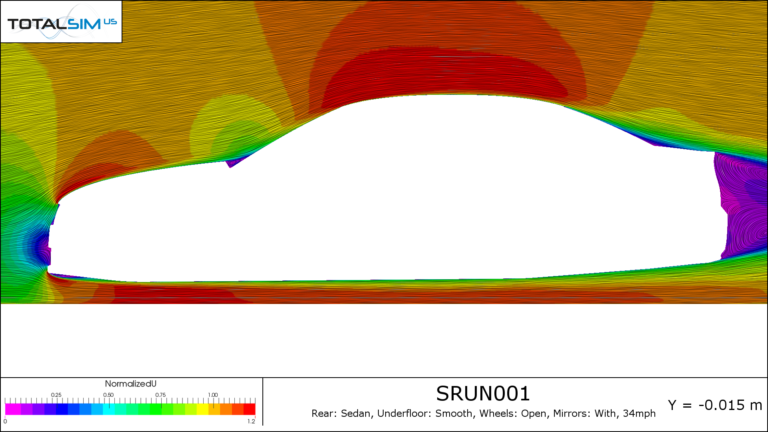
The left image shows pressure contours around a typical sedan profile. The image on the right shows the same solution colored by Normalized Velocity contours and overlaid with the in-plane streamlines. The area above the greenhouse where flow is at it’s highest velocity correlates to a region of low pressure. Also notice how, at the rear of the car, the streamlines angle downwards.
For most OEM vehicles the lift seen during normal operating conditions is insignificant enough that it’s not a concern to vehicle handling. However, for vehicles that really push the envelope in terms of speed and performance, the lift on a car needs to be dealt with – the most common methods being spoilers and wings.
Spoilers
A spoiler does exactly as it’s name suggests, it “spoils” the lift locally somewhere on the car. For the dirt car model, the spoiler serves to spoil lift generated on the top rear of the car. For most cars with an unsophisticated underfloor, flow accelerates around the curvature of the upper surface. Recall that we concluded from Bernoulli’s Principle that lower velocities are usually associated with higher static pressure. In the above example on the sedan, the pressure on the rear deck of the car is slightly higher than ambient, but the velocity in that region is still far from zero. If instead we were to add a large obstruction, for example a nearly vertical wall (a.k.a the spoiler), the flow in that local region would slow even further and we would have an even higher local static pressure. This is exactly what is done on the Dirt Late Model where a very large rear spoiler is used.
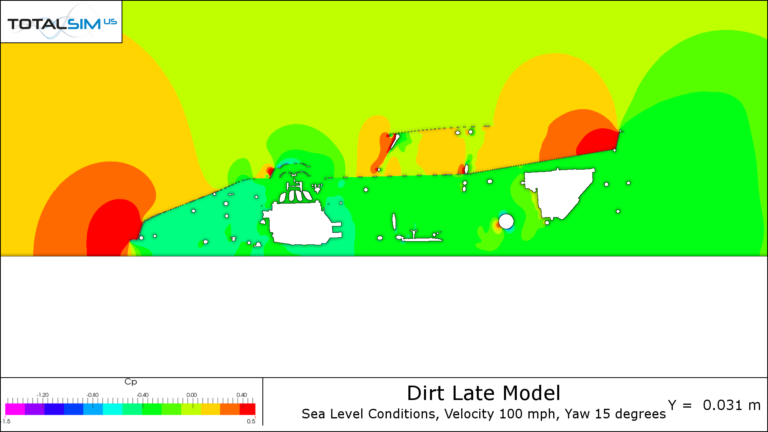
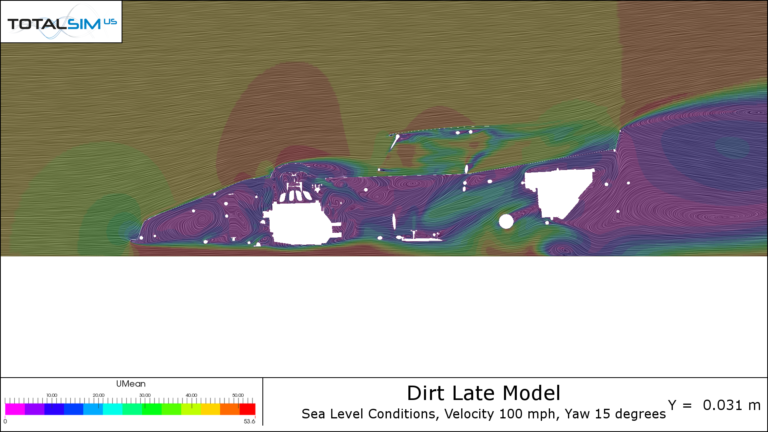
The presence of the spoiler at the rear of the car has significantly increased the local static pressure thereby “spoiling” the lift on the upper surface of the vehicle. Looking at the velocity contours, the flow locally has slowed down, again consistent with our velocity/pressure relationship via Bernoulli’s principle. Interestingly also note that the streamlines no longer just follow the contour of the upper surface of the car but rather, as the flow proceeds over the spoiler, are forced upward. This flow turning adds downforce and has some interesting secondary effects on the lower surface of the car (which are a bit out of the scope to explain here but also serves to add additional downforce to the vehicle by aiding the underfloor flow).
The image below shows volume streamlines overlaid on top of the vehicle. The spoiler redirects airflow and the streamlines (colored by pressure) are forced upward and have noticeably higher pressure above the spoiler. As a final note, spoilers need not always be a vertical dam nor are they always for spoiling lift, but whatever form they appear in, as long as they’re serving to “spoil” some aerodynamic flow feature they’ve earned their moniker!
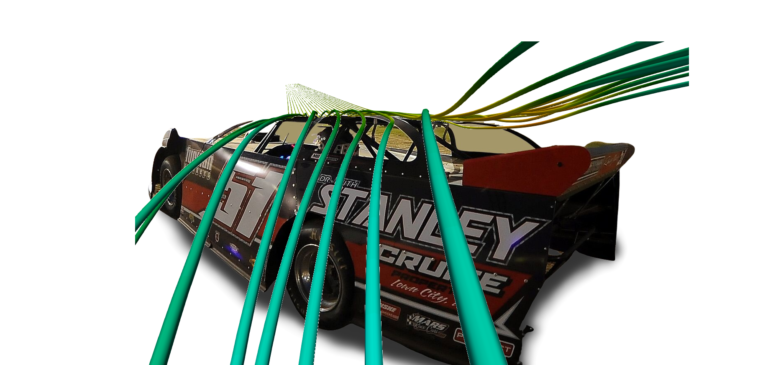
Wings
A racing wing is a device that uses a similar profile to an aircraft wing except that it’s been inverted to produce “negative lift” or “downforce”. Engineers typically set rear wings set high and away from the body, as allowed by the rules. This maximizes the amount of “clean” airflow onto the wing thereby maximizing the downforce generated.
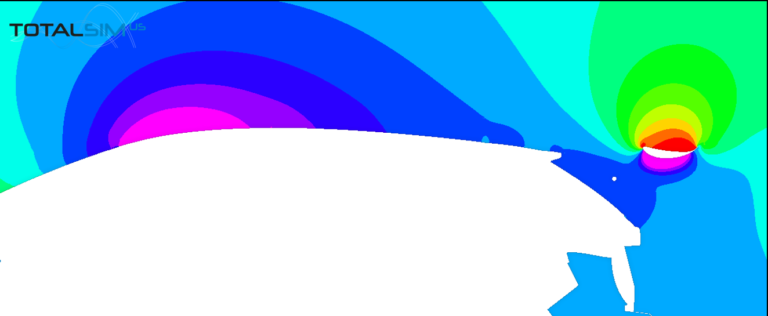
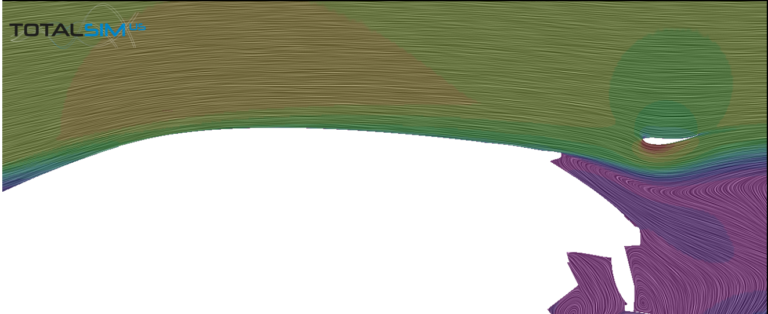
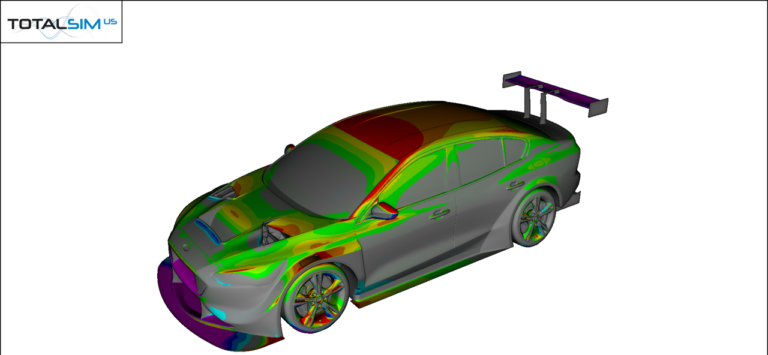
The images above are of racing “touring car” (TC) we’ve worked on. The image on the left shows pressure contours around a vehicle and the rear wing. The image on the right shows velocity magnitude with the in-plane streamlines. Again you can see that the regions of low pressure and high velocity coincide underneath the wing. On the bottom-middle, the vehicle is colored by CpZ, [if you need a refresher on what CpZ is, please visit our previous article on the Dirt Late Model]
The rear wing shown here has strong low pressure under, and a strong high pressure above itself, both of which serve to ‘pull’ and ‘push’, respectively, the wing downwards. By attaching the wing to the vehicle, the downward force on the wing transfers to the vehicle and ultimately to the tires ultimately providing more grip when turning the vehicle. Similar to spoilers, rear wings have the secondary effect of helping drawing more flow out from underneath the vehicle which further aides in the production of overall downforce.
Concluding Remarks
Intuitively, wings are more effective at increasing downforce than a spoiler because a spoiler works on a single surface while wings work on both upper and lower surfaces of the the device. However, efficiency is not always measured in downforce production. Wings have a side effect of creating drag. The net force direction on a wing is rarely in the pure downwards direction, often times it includes a rearwards component and when you have both the upper and lower sides working to produce a force, the rearwards component, although a small fraction of the force, can amount to a sizable drag penalty. In addition, wings create vortex induced drag which can be somewhat mitigated with properly designed endplates.
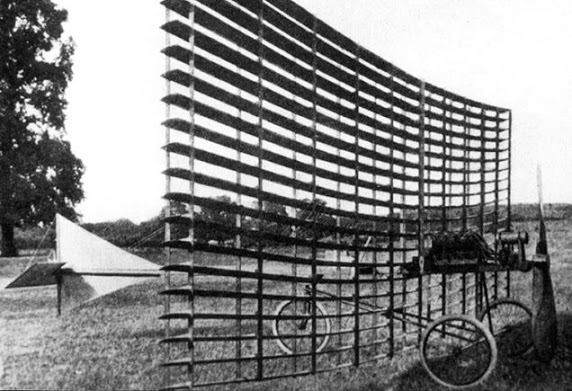
Too many wings… Just. Too. Many. [3]
Counter-intuitively, often times spoilers can end up reducing the lift load without a large drag penalty. Remember that spoilers are there to “spoil” some sort of aerodynamic flow feature. Spoiling lift is only one of several ways to use a spoiler.
Think of it this way: wings add aerodynamic load and as a result you pay a drag penalty. Spoilers serve to remove aerodynamic loads and thus sometimes (just sometimes) might end up also reducing a drag penalty…. Aero is both simple and complicated at the same time!
About TS Auto Application
TotalSim has developed a series of “pay-as-you-go” web application that are made accessible via a custom web portal. All of the Apps are based on the internal TotalSim workflows and recipes. TS Auto is a web-based application for performing highly accurate CFD simulations on auto vehicles including concept cars, OEM, and all types of race cars. The App will automate your entire CFD process from meshing to setting up the CFD solver to generate post-processing data. All you have to do, as the user, is to upload geometry and input basic run settings. The App also includes a suite of post-processing tools for you to analyze the results. Please visit our TS Auto page for more information.
About TotalSim
TotalSim was founded in 2009 as a full-service computational fluid dynamics (CFD) consulting and solutions group that provides decades of engineering knowledge and insight to clients in the automotive, racing, aerospace and industrial industries. We are headquarted in Dublin, Ohio, with an additional office in Pasadena, California. We also have a sister company in Brackley, England.
What we do
To put it simply, we use cutting-edge technology to help you solve your most complex engineering problems. With decades of experience in aerodynamics and design, our goal is to assist you in taking your ideas from initial concept to high performance reality.
In addition to CFD consulting and custom software, we offer industry-specific applications, training, support and hardware to ensure your product is performance-ready.
What makes us different? We are a relationship-driven company that:
Accelerates every stage of design and development through automated CFD calculations and workflows.
Simplifies complex CFD processes to empower our clients’ success.
Empowers clients at every stage with solver-agnostic solutions, support and training.
Customizes CFD tools and provides simulation apps tailored to automotive, truck and aerospace designs.
Credits
[1] Dirt Late Model Photos by Boyd
[2] Dirt Late Model CAD file drawn by Matthew Furman
[3] Image obtained from Aviastar

